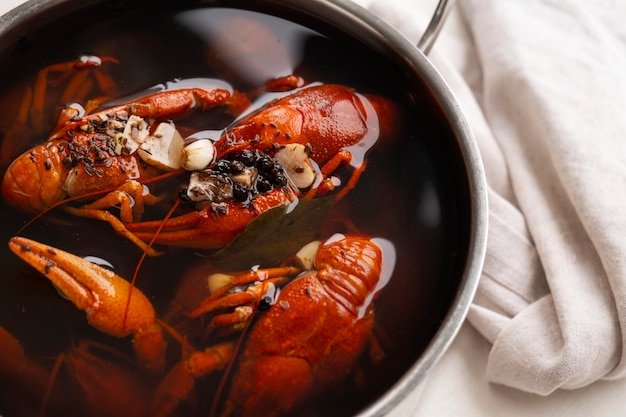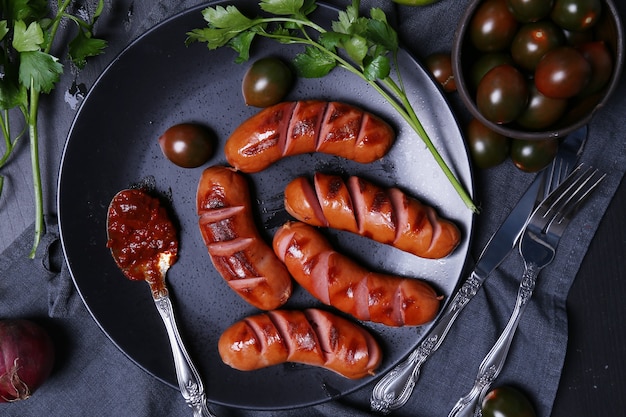Let's be honest, there's something undeniably exciting about the vibrant red hue of a plump chorizo sausage. It practically screams, "I'm full of flavour!" And you know what? It's true. Beef chorizo, in particular, holds a special place in my culinary heart. It's this delicious, spicy, smoky sausage that's a bit of a chameleon, blending seamlessly into various dishes and transforming them into something extraordinary.
But before you dive headfirst into the world of chorizo cooking, it's good to have a bit of a roadmap, right? That's where I come in. Over the years, I've had my fair share of chorizo triumphs (and a few disasters, let's not pretend!), and I'm here to share the wisdom I've gained. Consider this your ultimate guide to unlocking the secrets of delicious chorizo cooking.
We'll cover everything from choosing the perfect chorizo to prepping it like a pro. You'll learn about different cooking techniques and discover some truly mouthwatering recipes. By the end of this journey, you'll be a chorizo master, capable of conjuring up culinary masterpieces that'll have your tastebuds singing!
(Part 1) The Journey Begins: Choosing Your Chorizo

The Art of Choosing: Finding Your Perfect Chorizo
Imagine yourself in a bustling market, surrounded by colourful displays of chorizo, each one promising a different flavour adventure. It can be a bit overwhelming, right? That's why understanding the different types of chorizo is crucial. The key to finding your perfect chorizo is knowing what you're looking for.
Beef chorizo, unlike its pork-heavy counterpart, offers a leaner, less intensely fatty flavour. This makes it ideal for those who want a bit more control over their fat intake. However, don't let that fool you; it still packs a punch when it comes to flavour.
You'll find a spectrum of beef chorizo, ranging from subtly spicy to fiery hot. Some will have a rich paprika base, while others will tantalize with notes of cumin or smoked pepper. If you're adventurous, explore chorizo with a hint of citrus or even a touch of sweetness. The beauty of chorizo is its incredible versatility.
Fresh vs. Cured: A Tale of Two Chorizos
When you venture into the chorizo aisle, you'll likely encounter two main types: fresh and cured. Understanding the differences between these two is essential for getting the best results in your cooking.
Fresh chorizo, your go-to for quick and easy meals, is usually found in the refrigerated section of your supermarket. It's made with a blend of pork and beef, typically seasoned with paprika, garlic, and other spices. You'll recognise it by its slightly pink colour and soft texture.
Cured chorizo, on the other hand, is a more intensely flavoured, dried sausage that requires no cooking. This kind is usually found in the deli section, and it's perfect for adding a flavour punch to sandwiches, salads, or charcuterie boards.
For this guide, we'll be focusing on the magic of fresh chorizo. It's wonderfully adaptable, perfect for grilling, frying, sautéing, and a whole host of other culinary creations.
(Part 2) Preparing Your Chorizo: Getting Ready to Cook

Unwrapping the Treasure: A Simple Yet Important Step
Alright, you've found your perfect chorizo. Now it's time to unveil its secrets. Usually, you'll find it encased in a natural casing, usually made from sheep intestines. Don't worry, it's just a protective layer; it doesn't affect the flavour at all.
Whether you cook your chorizo with the casing on or off is a matter of personal preference. Leaving it on adds a rustic, slightly chewy texture. However, removing the casing allows the chorizo to cook more evenly and releases its flavours more readily.
To remove the casing, simply make a small slit with a sharp knife and carefully peel it off, working your way down the chorizo. If it sticks in places, a toothpick or a small knife can help loosen it up.
Prepping for Perfection: A Few Quick Tips
Once you've unwrapped your chorizo, you'll need to decide how you want to cook it – whole or sliced. If you're cooking it whole, tie it off at both ends with kitchen twine to prevent it from unraveling. This is ideal for grilling or roasting.
For frying or sautéing, slicing the chorizo into your preferred thickness is the way to go. I usually go for slices around half a centimetre thick. This ensures even cooking and allows the flavours to release beautifully.
(Part 3) Cooking Your Chorizo: A Journey of Flavour

Now for the fun part – cooking your chorizo! Each method brings out unique qualities in this incredible sausage, so it's worth experimenting to find your favourite techniques.
Grilling: Embracing the Smoky Delights
Grilling chorizo is a simple yet satisfying way to bring out its smoky flavour and create a delightful crispy exterior. For gas grills, preheat to medium-high heat, then place your chorizo on the grill. Cook for about 5-7 minutes per side, or until it's cooked through and boasts gorgeous grill marks.
If you're using a charcoal grill, keep an eye on the heat to avoid burning the chorizo. Remember to turn the sausage every couple of minutes for even cooking. Don't be afraid to embrace a touch of char; it adds depth and character to the flavour.
Frying: A Quick and Easy Culinary Fix
When time is of the essence, frying is the perfect solution. Heat a tablespoon or two of olive oil in a frying pan over medium-high heat. Then, add your chorizo slices and cook for about 5-7 minutes, or until they're cooked through and beautifully golden brown.
For an extra flavour boost, add some sliced onions or peppers to the pan while the chorizo is cooking. The combination of sweetness and spice is truly delightful.
Sautéing: Unlocking Versatile Possibilities
Sautéing is a fantastic way to cook chorizo when you're planning to use it in a dish like pasta, rice, or a hearty stew. Simply heat a tablespoon or two of olive oil in a frying pan over medium heat. Add your chorizo and cook for about 5-7 minutes, or until it's cooked through.
While the chorizo is sautéing, you can add other ingredients like garlic, onions, or peppers to create a symphony of flavour. It's a great way to build the foundation for a delicious and satisfying meal.
(Part 4) Beyond the Basics: Taking Chorizo to the Next Level
Now that you've mastered the fundamentals, let's explore some exciting chorizo recipes that will take your culinary game to the next level.
Spicy Chorizo with Garlic and Chilli: A Flavour Bomb
This recipe is a personal favourite, perfect for a quick and satisfying meal. It's all about the bold combination of spice and umami. Here's what you'll need:
- Chorizo (fresh, sliced)
- Garlic (cloves, minced)
- Chilli flakes
- Olive oil
Heat a tablespoon of olive oil in a frying pan over medium heat. Add your chorizo slices and cook for about 5-7 minutes, or until they're cooked through. While the chorizo is cooking, mince a couple of cloves of garlic and add them to the pan. Then, sprinkle in a generous pinch of chilli flakes and cook for another minute or two, until the garlic is fragrant.
This spicy chorizo dish is best enjoyed with crusty bread for dipping and a refreshing green salad on the side. It's a perfect combination of bold flavours and satisfying textures.
chorizo and bean stew: A Hearty and Comforting Treat
For a comforting and flavourful meal that will warm you from the inside out, look no further than this hearty chorizo and bean stew. It's a perfect dish for chilly evenings. Here's what you'll need:
- Chorizo (fresh, sliced)
- canned beans (your choice, but kidney beans or black beans work well)
- Onion (chopped)
- Garlic (cloves, minced)
- Tomato paste
- Vegetable stock
- Herbs (fresh or dried, like thyme, oregano, or rosemary)
Start by heating a tablespoon of olive oil in a large pot over medium heat. Add your chorizo slices and cook for about 5-7 minutes, or until they're cooked through. While the chorizo is cooking, chop an onion and mince two cloves of garlic. Add these to the pot and cook for a few minutes, until the onion is softened. Then, stir in a tablespoon of tomato paste and cook for another minute or two.
Add your chosen beans, vegetable stock, and your favourite herbs. Bring the stew to a boil, then reduce the heat and simmer for about 30 minutes, or until the beans are tender. Serve this comforting stew with crusty bread for soaking up all the delicious flavours.
chorizo and potato hash: A Versatile and Delicious Dish
This chorizo and potato hash is a fantastic way to use up leftover chorizo and create a quick and satisfying meal. It's perfect for breakfast, brunch, or even a light dinner. Here's what you'll need:
- Chorizo (fresh, sliced or crumbled)
- Potatoes (peeled and chopped into small pieces)
- Onion (chopped)
- Pepper (chopped)
- Olive oil
Heat a tablespoon of olive oil in a large frying pan over medium heat. Add the potatoes and cook for about 10-15 minutes, or until they're tender and slightly golden brown. While the potatoes are cooking, chop an onion and a pepper into small pieces. Add them to the pan and cook for a few minutes, until the onion is softened. Then, add your chorizo slices (or crumbled chorizo) and cook for another 5-7 minutes, or until it's cooked through.
For an extra touch of indulgence, serve this chorizo and potato hash with a fried egg on top. It's a simple yet delicious dish that's packed with flavour and texture.
(Part 5) Serving Up Your Chorizo: Creating a Culinary Symphony
Your chorizo is cooked to perfection, and now it's time to showcase its flavours. The beauty of chorizo is its versatility. It's like a blank canvas, ready to be transformed into something amazing with the right accompaniments.
Pairing Chorizo with Sides: A Culinary Harmony
Here are some of my favourite ways to elevate your chorizo dishes with complementary sides:
- Crusty bread: A classic pairing for soaking up the delicious juices and flavours of the chorizo. Choose a hearty, rustic bread with a slightly chewy texture for the perfect contrast.
- Green salad: A fresh and light salad is a wonderful way to balance out the richness of the chorizo. Think crisp lettuce, juicy tomatoes, and a tangy vinaigrette for a perfect counterpoint.
- Roasted vegetables: Roasted vegetables like carrots, potatoes, and peppers add a lovely sweetness and earthiness to the dish. The combination of roasted vegetables and spicy chorizo is a match made in culinary heaven.
- Rice: Rice is a classic side dish for chorizo, especially when you're making paella or a hearty stew. Choose a long-grain rice for a fluffy texture that complements the chorizo beautifully.
- Pasta: Pasta is another excellent choice, especially if you're creating a chorizo and tomato sauce. Use a hearty pasta shape like penne or rigatoni to stand up to the bold flavours of the chorizo.
Tips for Making Your Dishes Stand Out: Mastering the Art of Serving
Here are a few extra tips for serving your chorizo like a pro:
- Don't be afraid to experiment with different flavours and combinations. Chorizo goes well with a wide range of ingredients, so let your culinary imagination run wild.
- Use fresh, high-quality ingredients. The taste of your dishes will be significantly enhanced when you start with the best ingredients.
- Don't overcook the chorizo. You want it to be cooked through, but not dry and tough. A little bit of pinkness in the centre is perfectly fine.
- Let the chorizo rest for a few minutes before serving. This allows the juices to redistribute, making the chorizo even more tender and flavorful.
- Serve the chorizo with a generous drizzle of olive oil and a sprinkle of fresh herbs. This adds a final touch of flavour and elegance to your dish.
(Part 6) Beyond the Kitchen: The World of Chorizo
Now that you're a chorizo enthusiast, it's time to explore the fascinating world of this versatile sausage beyond the confines of your kitchen.
Chorizo Around the Globe: A culinary adventure
Chorizo is not just a British favourite; it's a global culinary treasure. It's used in a wide range of cuisines around the world, each adding its unique twist to this beloved sausage.
In Spain, chorizo is a staple ingredient in paella, a vibrant rice dish bursting with flavour. In Mexico, it finds its way into tacos, burritos, and other street food delights. Portugal embraces chorizo in a variety of stews and soups, showcasing its versatility in hearty, comforting dishes.
Unleashing Chorizo's Potential: Beyond Traditional Dishes
The possibilities for chorizo are truly endless. It's not just limited to traditional dishes. You'll find chorizo making a delightful appearance in pizzas, sandwiches, salads, and even some adventurous desserts (yes, you read that right!).
So, don't be afraid to get creative and experiment with new and exciting ways to use chorizo. You might be surprised at what culinary wonders you can create.
(Part 7) Chorizo and Wine: A Perfect Pairing
A culinary journey is never complete without the perfect wine pairing. Chorizo, with its rich, spicy, and sometimes smoky notes, offers a wonderful opportunity to explore the world of wine.
Pairing Tips: Finding the Right Wine Companion
Here are some tips for pairing chorizo with wine, ensuring a harmonious symphony of flavours:
- Consider the spice level of the chorizo. If you're using a spicy chorizo, opt for a wine with some acidity to balance out the heat. A light-bodied red wine like a Pinot Noir or a Garnacha is a good choice.
- Look for wines with fruit flavours. Chorizo pairs well with wines that have notes of red fruit, like cherry, raspberry, or blackberry. These fruity flavours complement the spice of the chorizo beautifully.
- Avoid overly oaky wines. Oaky wines can overpower the delicate flavours of the chorizo, creating an unbalanced taste experience.
- Don't be afraid to experiment. Wine pairing is a personal journey, so try different wines and see what you like best. There's no right or wrong answer when it comes to finding your perfect match.
Recommended Wine Pairings: A Taste of Wine Harmony
Here are a few of my favourite wine pairings for chorizo, guaranteed to enhance the flavour experience:
- Spicy Chorizo: Pinot Noir, Garnacha, Beaujolais. These light-bodied reds offer a refreshing acidity that balances out the spice of the chorizo.
- Mild Chorizo: Rioja, Cabernet Sauvignon, Malbec. These bolder reds complement the richness of the chorizo and offer a smooth, enjoyable pairing.
- Chorizo with Peppers: Syrah, Zinfandel, C??tes du Rh??ne. These wines with their notes of black pepper and spice create a harmonious pairing with chorizo and peppers.
(Part 8) FAQs: Your Chorizo Questions Answered
FAQs: Your Chorizo Questions Answered
You've explored the world of chorizo, learned how to cook it like a pro, and now you're ready to enjoy its deliciousness. But you might still have a few burning questions. Don't worry, I'm here to help! Here are answers to some of the most frequently asked questions about chorizo:
| Question | Answer |
|---|---|
| How do I store chorizo? | If you're using fresh chorizo, it's best to store it in the refrigerator for up to 3 days. You can also freeze it for up to 3 months. Just make sure to wrap it tightly in plastic wrap or aluminum foil to prevent freezer burn. |
| What can I do with leftover chorizo? | Leftover chorizo is a culinary treasure waiting to be used! You can crumble it and add it to scrambled eggs or omelettes, use it in pasta dishes, soups, stews, or even salads. It's a versatile ingredient that adds a delightful flavour punch to many dishes. |
| Is chorizo healthy? | Chorizo, like most sausages, is a high-fat food. However, it's also a good source of protein and iron. If you're watching your weight, enjoy chorizo in moderation and choose leaner cuts. |
| What is the difference between chorizo and pepperoni? | Chorizo and pepperoni are both cured sausages, but they have distinct flavours and ingredients. Chorizo is typically made with pork and beef, while pepperoni is usually made with pork and beef. Chorizo also has a stronger flavour than pepperoni, often with paprika and other spices. |
| What is the best way to tell if chorizo is cooked? | The best way to tell if chorizo is cooked is to check the internal temperature. It should reach an internal temperature of 160°F (71°C). You can also check the colour of the chorizo. It should be cooked through and have a golden brown colour. |
There you have it! You've embarked on a delicious chorizo journey, discovering its incredible versatility and exploring its place in various cuisines. Now, it's time to put your new skills to the test. Embrace the flavours, experiment with different recipes, and enjoy the journey of cooking with this amazing sausage.
Everyone is watching

Corn on the Cob: The Ultimate Guide to Perfectly Cooked Ears
Healthy MealsAh, corn on the cob. Just the name evokes images of sunny days, barbecues, and that sweet, juicy flavour that ...

Scallops: The Ultimate Guide to Perfect Cooking
Healthy MealsAh, scallops. Those delicate, sweet, and utterly delicious morsels of the sea. They hold a special place in my...

Spaghetti Squash: The Ultimate Guide to Cooking and Serving
Healthy MealsRemember that time you saw spaghetti squash at the supermarket, looking all bumpy and strange, and thought, "W...

Salmon Cooking Times: Perfect Guide for Every Recipe
Healthy MealsLet me tell you, cooking salmon is an art form. It's all about getting that perfect balance: juicy and tender,...

Ham Cooking Time: How Long to Bake, Smoke, or Boil a Delicious Ham
Healthy MealsAh, ham. It's a classic, isn't it? A real crowd-pleaser, especially around holidays. And when done right, it'...
